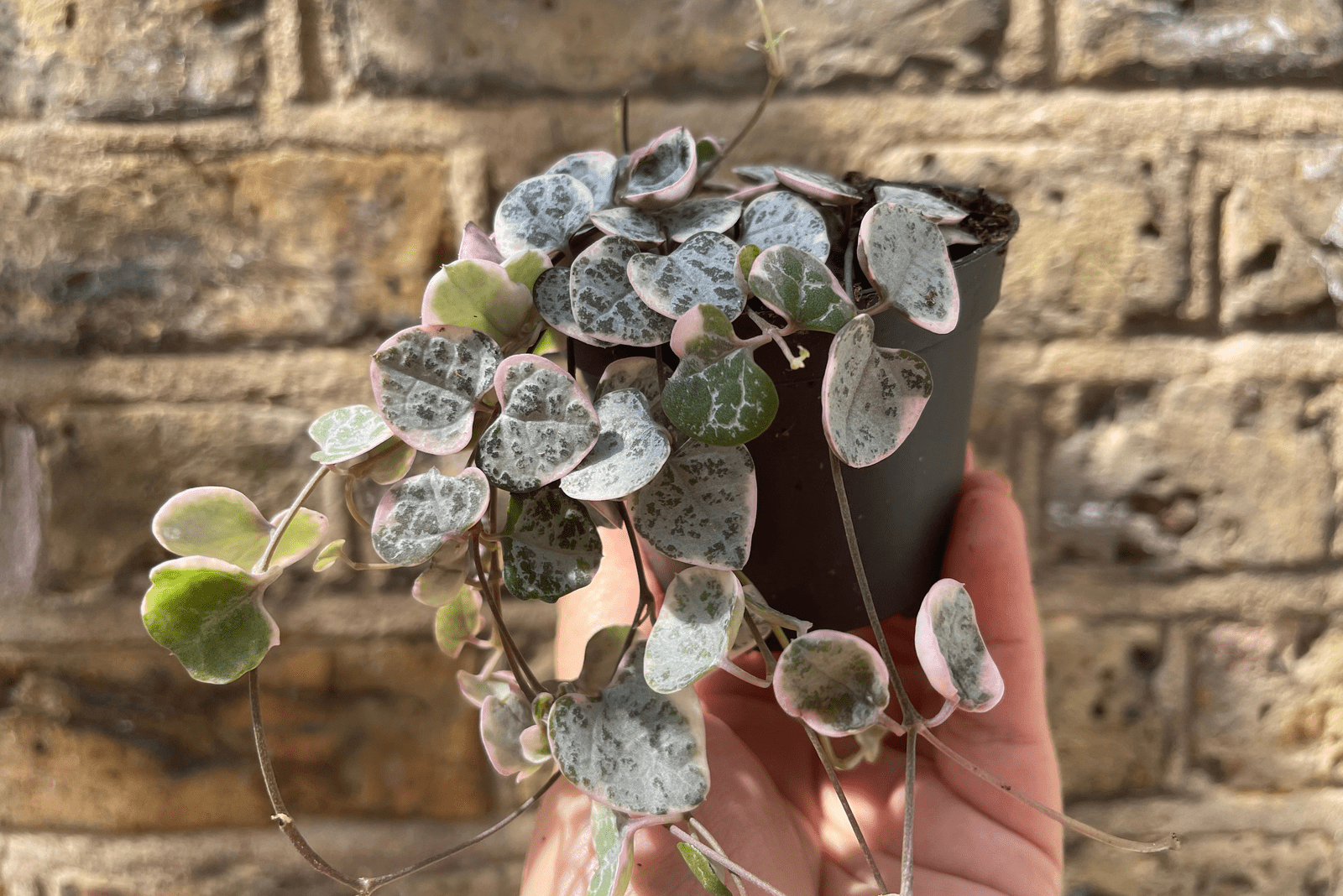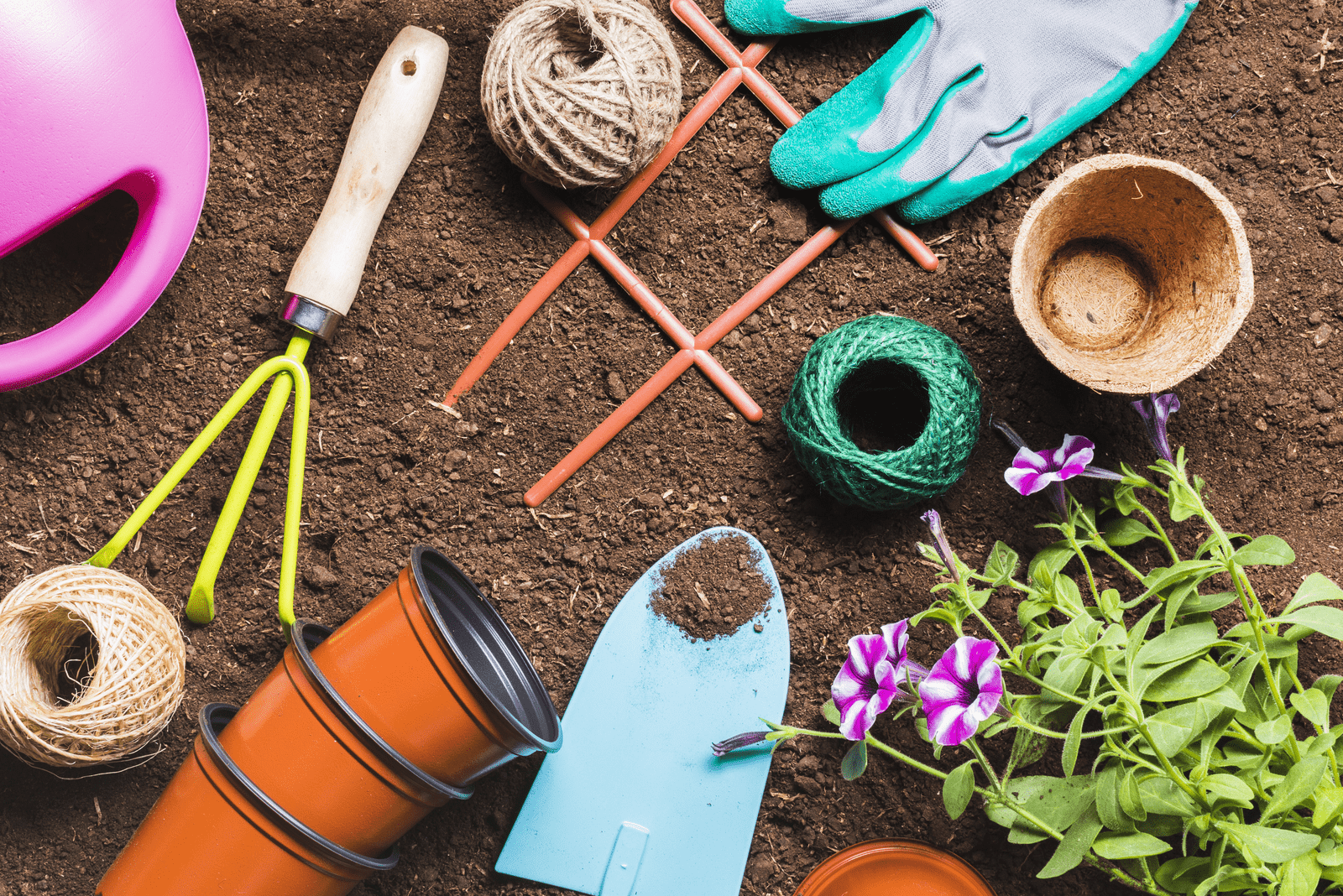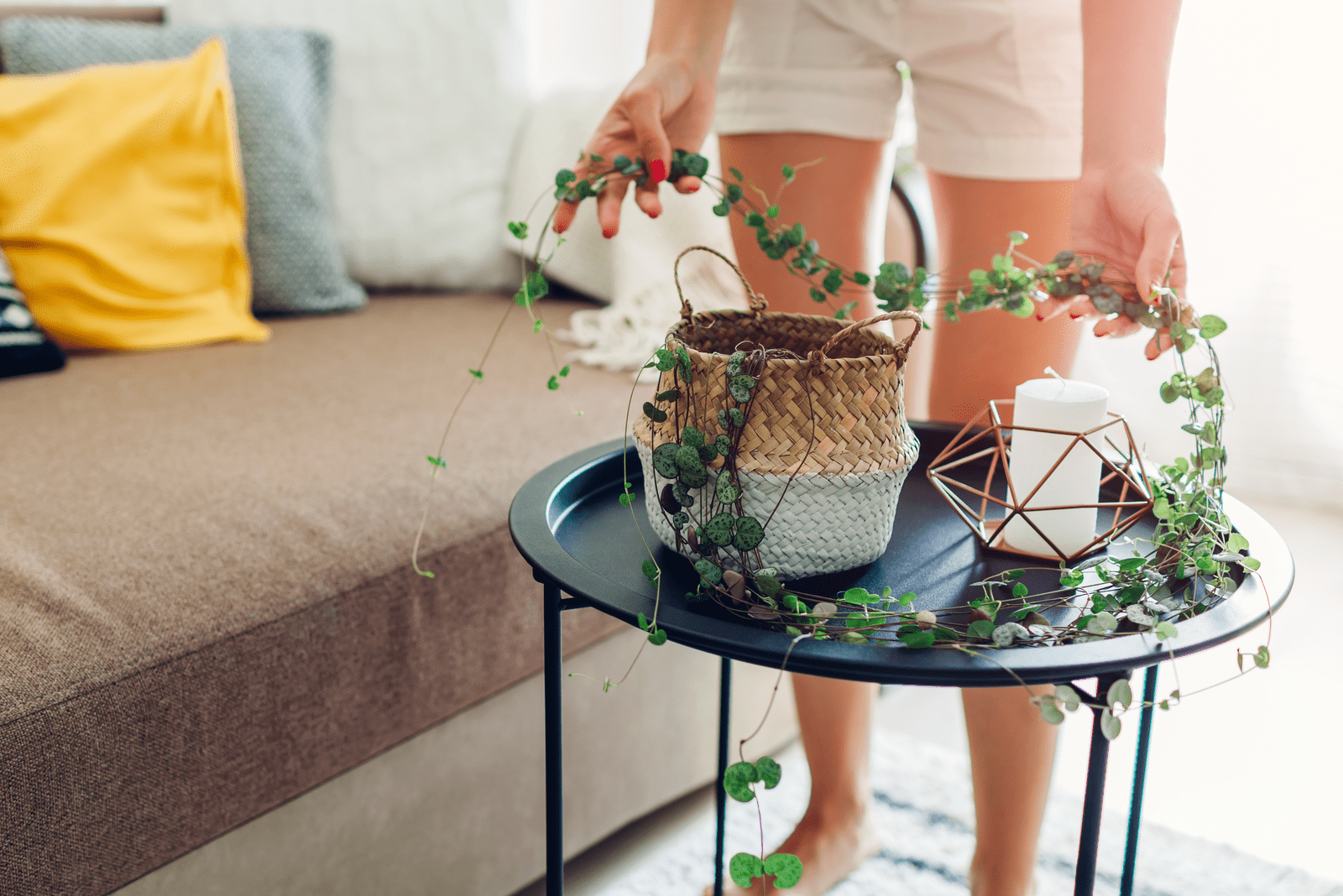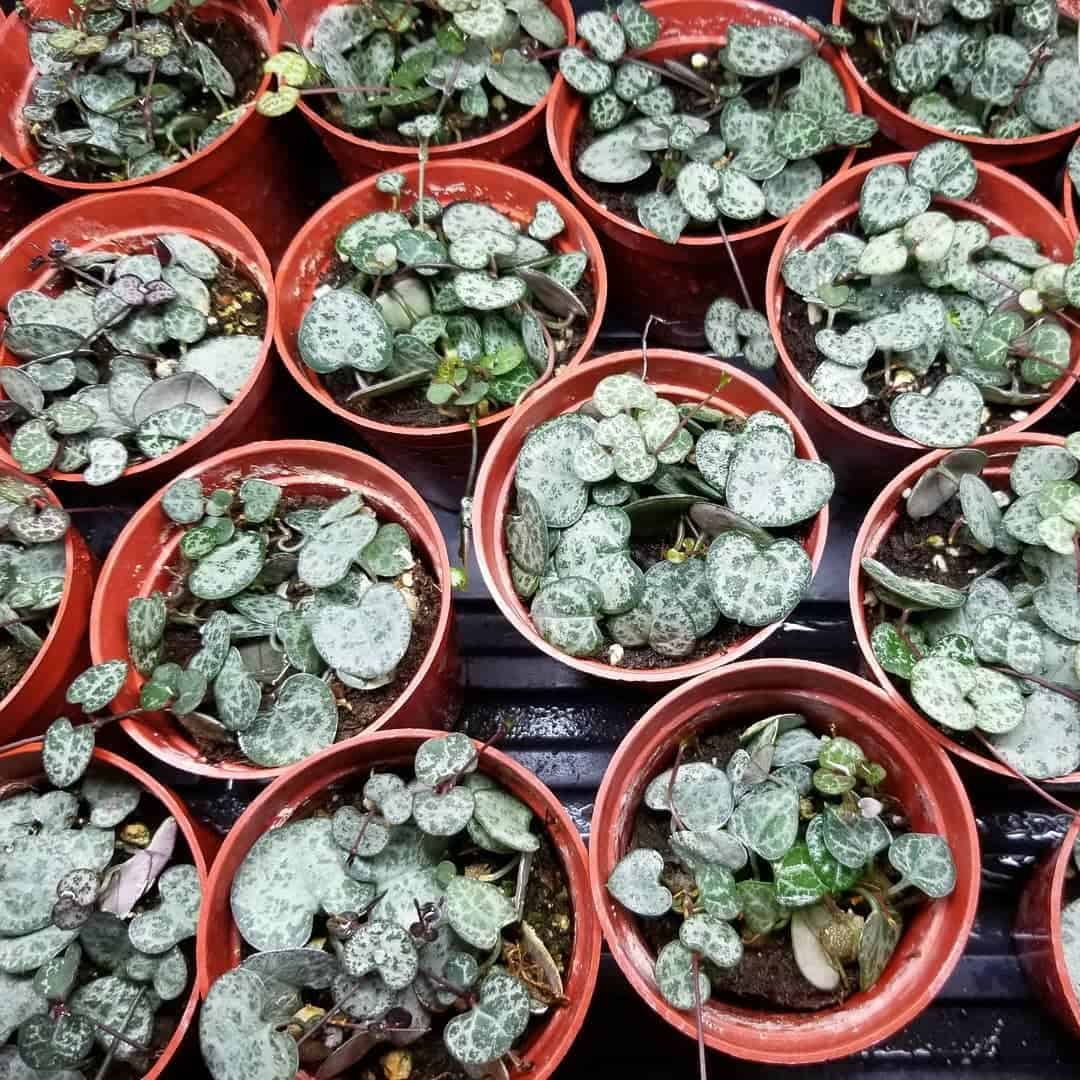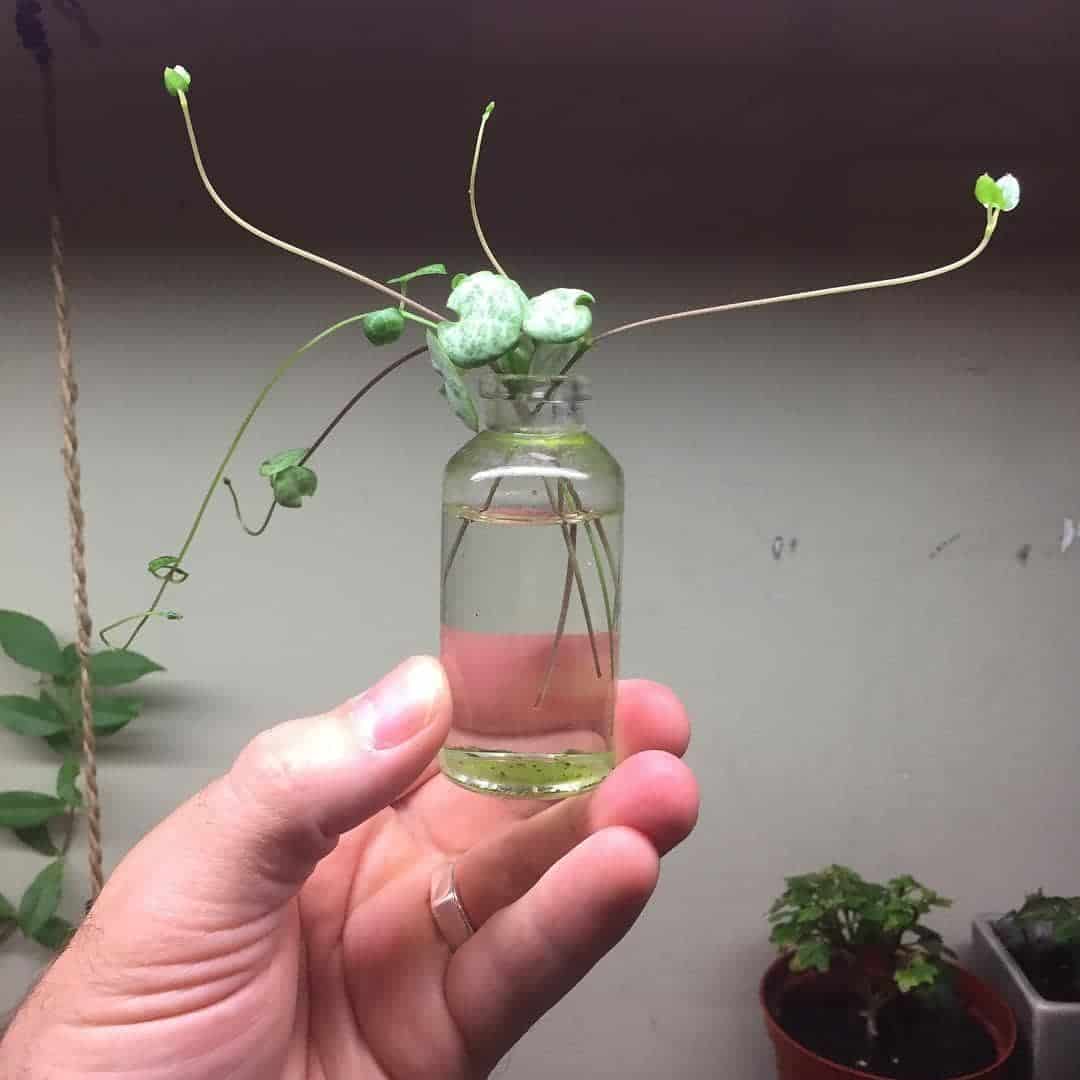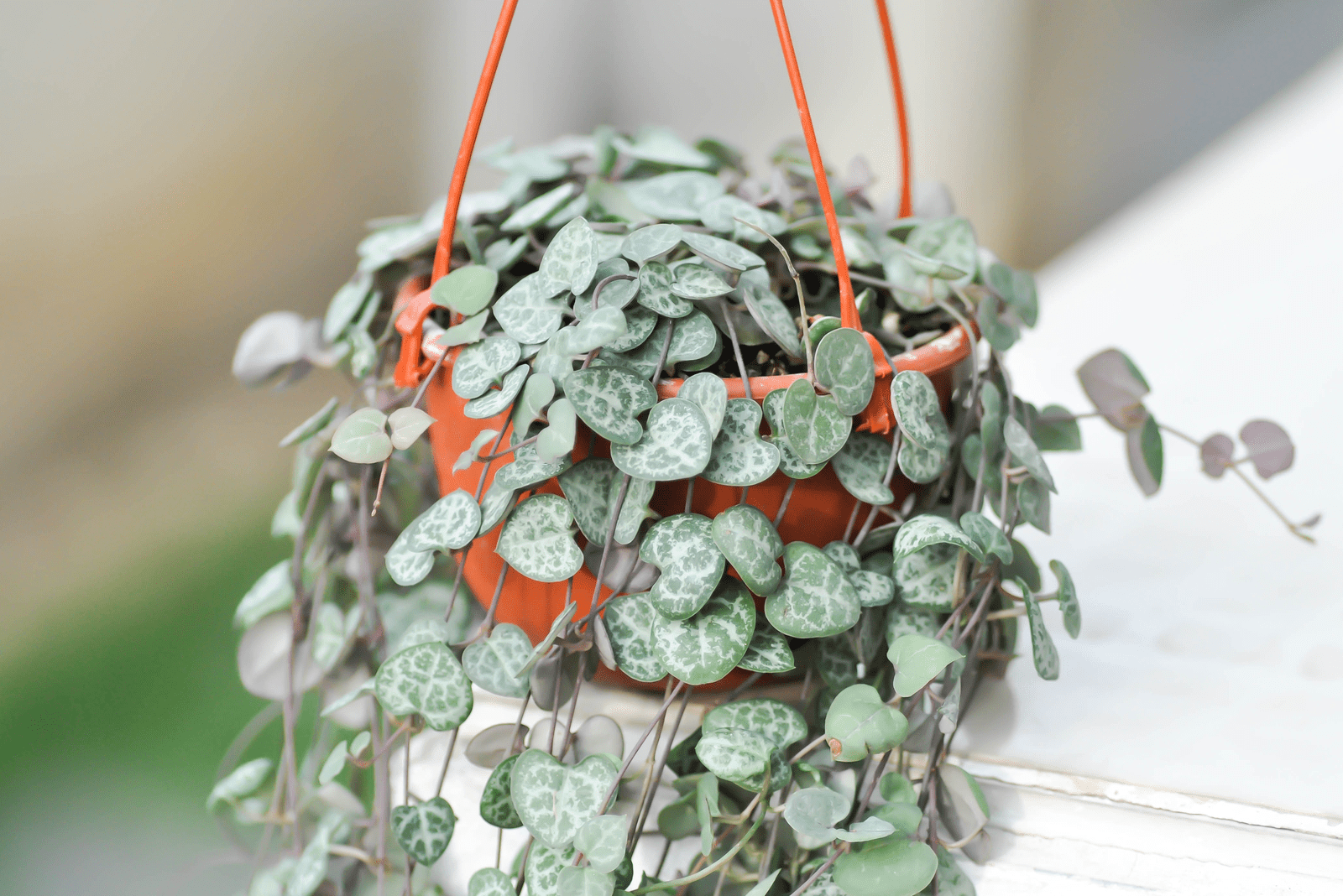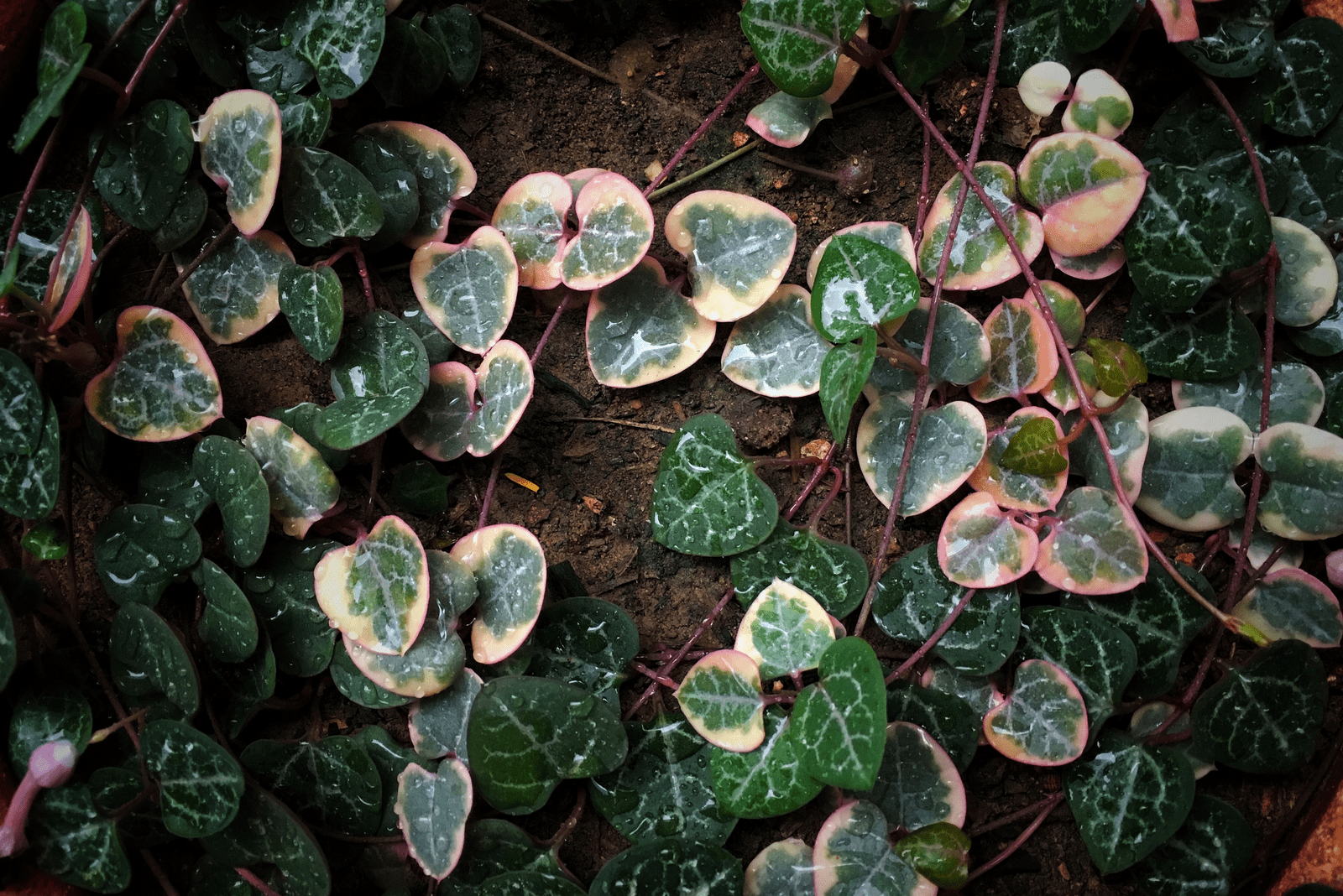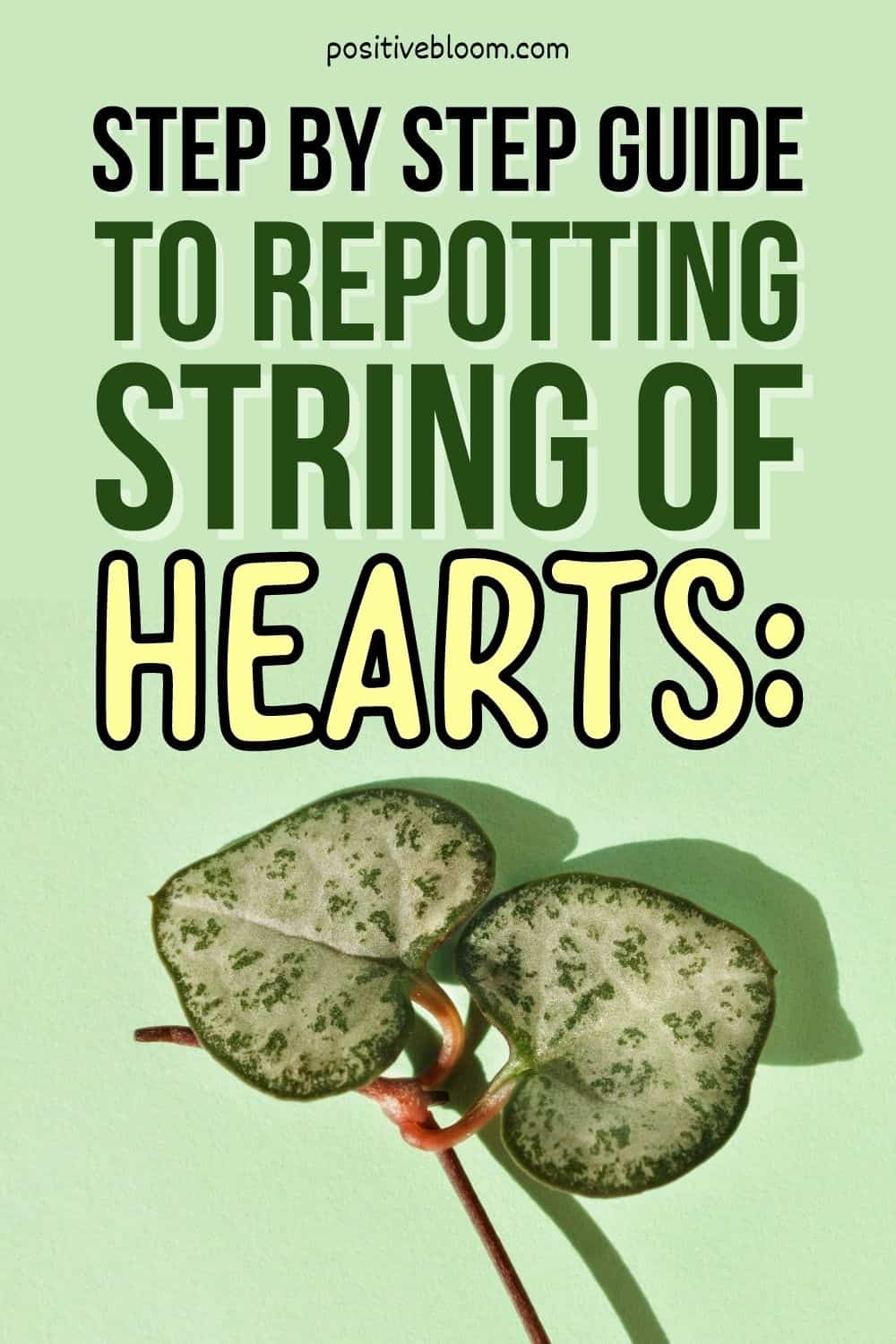The string of heart plant is one of the most popular hanging plants in the world.
Both the regular and variegated string of hearts will complete your beautiful plant collection.
Contrary to popular belief, this plant is perfect for beginners. It’s easy to care for, propagate, and even to repot!
Repotting string of hearts isn’t rocket science, and if you know the basics you will actually grow to enjoy it! Finding the right pot (material and size), perfect soil mix, and a couple of pro tips will make repotting as exciting as ever!
Before we move on, here is some basic info about the string of hearts.
| Family: | Apocynaceae |
| Genus: | Ceropegia |
| Scientific name: | Ceropegia Woodii |
| Common names: | String of hearts, rosary vine, chain of hearts, sweetheart vine |
| Native habitat: | South Africa, Zimbabwe |
| Type of plant: | Trailing vine |
Let’s get started!
Repotting String Of Hearts: Step By Step Guide
Preparing the tools, pot, and potting mix for your plant is only half the job! I also recommend you find an appropriate place for repotting because it can get a little messy!
It will get easier once you learn the basics of repotting, so make sure you read this step-by-step guide closely.
Let’s start with the potting mix!
Step 1: Choose A Potting Mix
It’s very important to choose a high-quality soil. Adequate soil is fundamental to your plant receiving the water and nutrients it needs.
Each plant requires different nutrients and different amounts of water. As far as the string of hearts is concerned, it needs well-draining soil that also retains water well.
Additionally, good airflow is essential for healthy growth.
This is reminiscent of succulents, and the rosary vine is actually considered a semi-succulent plant.
Buying one is the easiest way to get perfect soil. Succulent soil or cactus mix works perfectly for chain of hearts plants.
It’s possible to make your own soil mix, but you need to know a couple of things before you make your own potting mix.
DIY Soil Mix
To start with, you need to know which materials ensure good drainage. When it comes to soil mixes, perlite is the king of drainage. It’s non-toxic, improves drainage and aeration, and doesn’t smell bad.
Add perlite to your standard potting soil and enjoy the magic.
Another material great for this purpose is pumice. Mix it with coarse sand and add it to regular potting soil.
Here is my recipe for a string of hearts potting medium: cactus mix, coco coir, and perlite!
Step 2: Choose A New Pot
A rule of thumb when repotting is to use a pot 1 to 2 inches larger than the previous one.
This is because larger pots contain more soil, and plants grow roots to fill the air spaces of the surrounding soil.
The pot you chose is too large if you don’t see new leaves growing.
Additionally, more soil=more water, and the excess water stays around the roots, which can result in root rot.
Drainage holes are also very important. A pretty pot doesn’t always mean a functional pot, and you’ll definitely need one with drainage holes in the bottom.
Pro tip: Use a regular plastic pot and place it in a prettier one!
We have almost completed our ideal new pot for a string of hearts! The last requirement is the material it’s made of.
Pot Material
Plastic pots are pretty cheap and lightweight, and you can easily place them in cachepots.
However, I highly recommend terracotta pots. Terracotta is a porous material so you won’t need to worry about drainage, plus it looks amazing.
Now that you have an appropriate potting mix and a nice new pot, you can start repotting!
Step 3: Remove The String Of Hearts Plant From The Pot
Moving plants to new pots can be tricky, especially if you like doing things fast.
Although it may seem easy just to grab your string of hearts and pull it as hard as you can, that is the worst thing you can do!
It’s better to let the soil dry completely before you start repotting, which will ease the process of removing the plant from the pot.
Gently hold the base of the rosary vine and tap the pot. Now wiggle your chain of hearts to loosen it a bit.
Squeeze the bottom of the pot gently to dislodge the roots. Alternatively, try to separate the soil from the pot with a knife.
Step 4: Loosen Up The Roots
Now your string of hearts is out, your next goal is to expose the roots by removing the soil around them.
This is where things can go wrong; if your string of hearts is rootbound, prepare your nerves and strength because any mistake could result in irreparable damage to the roots.
You can either manually free the roots or use a tool to break apart the clumped soil.
Starting at the bottom and working your way to the upper roots near the stem is the best option (remember, slowly but safely)!
Step 5: Remove Any Diseased Roots
You should carefully inspect the roots before placing your string of hearts in a new pot. Placing a plant with diseased roots in a new pot will often result in death because it needs to adapt after replanting, and this is impossible with diseased roots.
If you are lucky and there aren’t any diseased roots, proceed with replanting.
Healthy rosary vine roots should be grayish-white and firm, whereas diseased ones are mushy and black/brown.
Sanitize your pruners/scissors/knife and remove ALL damaged roots.
Step 6: Put Your Plant In The New Pot
Your sweetheart vine and its roots are now free, clean, and ready for their new home.
Fill half of the pot with the potting mix you prepared and make a hole deep enough to fit the plant, then place your rosary vine in the soil. Add the remaining soil to the pot and gently press the soil around the plant.
Remember, the plant should stand firm.
Step 7: Water Your Repotted Plant
The best way to help your plant adapt after replanting is by watering it.
Don’t spare the water; water your string of hearts plant thoroughly and let it drain well.
Wait until the top of the soil dries out before watering again.
Place the freshly replanted string of hearts in bright indirect light.
Your plant should adapt soon, and then you can continue with the usual care.
Read on to learn about the string of hearts care.
When To Repot The Ceropegia Woodii
Photo from: @jmtplants
It would be best to repot your Ceropegia woodii when you notice its roots protruding from the drainage holes.
I always say that replanting is like moving into a new home as our family grows. For plants, it’s a great way to start fresh.
The sweetheart vine is dormant in the winter months, so I recommend skipping replanting during that time.
The best time to repot a chain of hearts plant would be at the beginning of spring. This will enable it to flourish even more rapidly throughout the summer, which is its growing season.
You should also repot a string of hearts if it is suffering from root rot or more than 2 years have passed since the last replanting.
The Benefits Of Repotting
Houseplants love replanting! It gives them more space and new nutrients, and it also gives us the opportunity to divide the root ball and use the sections for propagation.
Let’s get into details!
More Growing Space
‘Old plants’ and new plants develop roots constantly. The soil becomes too compact over time so the roots can’t grow or breathe.
If you skip replanting, your plants will display stunted growth and may even die.
Larger pots provide more growing space, so the roots can spread undisturbed.
Remember that roots send nutrients to the other parts of the string of hearts, which means your plant can’t survive without healthy roots.
Fresh Soil
New soil is like a new beginning! Soil loses nutrients over time, and that’s completely normal.
The problem with old soil is that it is attractive to pests and fungi and gets contaminated over time.
Replacing old soil with fresh provides new nutrients essential for healthy growth.
I always discard the old soil, and I strongly suggest you do the same. Also, never add the old soil to your compost pile if you have one, as it may be contaminated.
Propagation
Plants like the string of hearts can be propagated by division.
Each time you remove it from its pot, you can divide the roots and use them for propagation.
This is the easiest way to expand your plant collection. If you like the string of hearts as much as I do, a lot of new plants will make you really happy!
How To Propagate String Of Hearts
Photo from: @teenytinyterra
I will show you the two most common propagation methods for Ceropegia plants, including the string of hearts and string of pearls, which are stem cuttings and tuber propagation.
Let’s take a look!
Propagation By Stem Cuttings
To propagate your string of hearts by stem cuttings, you’ll need a pot, potting mix, a sharp and sanitized knife, and a rooting hormone.
Here are the steps:
• Stem cuttings will need well-draining soil, so you can either use a succulent mix or combine pumice, perlite, and coarse sand.
Mist the soil mix, but carefully because stem cuttings and damp soil are a bad combination.
• Now you take the cuttings. Choose a string of hearts vine about 4 inches long with a node. Make an incision above the nub using a sharp and sanitized knife.
• Put the string of heart cuttings in the soil and place the pot in a humid area with bright indirect light.
You can also put a plastic bag over the pot to ensure enough humidity. Remove the bag when new growth begins to appear.
Propagation By Tubers
If you want to grow a lot of new string of hearts plants, you can separate all the individual tubers.
The tubers are located in a number of places, including on the soil’s surface, below the topsoil, and on the vines (aerial tubers).
The method for propagating the tubers discovered above or below the soil is exactly the same.
Aerial tubers must first root, and then new stems will appear.
Now, let’s propagate!
• Divide the tubers (above or below the soil). If some of the tubers don’t have any roots attached, don’t worry because it won’t affect the success.
• Put one of the string of hearts tubers in the soil. If it has any roots, make sure to place them in the soil.
• Water the topsoil. Remember, your goal is to keep the soil moist but not waterlogged.
• Until new growth occurs, your tubers will need plenty of bright indirect light.
String Of Hearts Care Guide
The easiest way to avoid any issues is by taking good care of your plant.
To help you learn how to properly care for this unique plant, here is a short string of hearts plant care guide.
Light Requirements
Your sweetheart vine needs bright indirect light – nothing more and nothing less.
This is because both extremes can cause damage to your plant. For example, if you leave your Ceropegia woodii in low light for an extended period, you’ll notice that it doesn’t grow well anymore.
On the other hand, if your rosary vine is left in direct sunlight, the leaves will scorch and your plant will likely end up with severe burns.
I recommend placing your sweetheart vine in an east-facing window so it gets some dappled morning sunlight.
You can alternatively place your string of hearts in a south-facing window with sheer curtains to prevent direct sunlight reaching the plant.
If you aren’t sure if your plant is receiving enough light, you can consider getting grow lights.
Humidity Requirements
This plant is native to South Africa, which is quite a humid place.
You should try to imitate that environment as closely as possible to help your string of hearts grow healthy with a humidity level of 40 to 60 percent. I advise investing in a hygrometer, which will show you the humidity level in your house.
If humidity falls below 40%, you’ll need to increase it as soon as possible. You can put your rosary vine close to other indoor plants, use a humidity tray, or invest in a humidifier to do this.
Temperature Requirements
The sweetheart vine thrives in temperatures between 60 and 80 degrees Fahrenheit.
Never let the temperature drop below 40 degrees Fahrenheit because these plants aren’t cold-tolerant and it could quickly kill them.
Never place your string of hearts near heat sources, fans, or air conditioners. This plant is extremely sensitive to temperature fluctuations and cold drafts.
Watering
The string of hearts needs a different watering schedule during the growing season and the winter months.
The sweetheart vine grows actively in spring and summer and will need more water in this period because it spends more energy.
On the other hand, Ceropegia woodii is dormant during the winter months. It doesn’t use energy, so it doesn’t need much water.
Unlike many other common houseplants, the rosary vine prefers the soil to dry out entirely between waterings.
Therefore, the perfect watering schedule for a string of hearts is simply waiting until the soil dries out completely.
Fertilizing Chain Of Hearts
Your chain of hearts loves food! I recommend fertilizing it regularly using fertilizer made specifically for succulents.
Ceropegia plants are sensitive to higher concentrations of nitrogen in the soil, and fertilizers for succulents don’t contain much nitrogen.
Pruning
The Rosary vine is a hanging plant, and its vines can easily take over your house or garden if they aren’t pruned on a regular basis.
The string of hearts can be pruned to achieve a desired shape, but trimming is essential if you observe any yellow, dead, or otherwise damaged leaves.
Your string of hearts will also appreciate some pruning if it becomes leggy.
I routinely sanitize my pruners before using them as I don’t want my precious rosary vine to catch any diseases.
Common Issues
Ceropegia plants aren’t too prone to diseases or pests, especially if you take good care of them.
The most common reason for a diseased string of hearts is overwatering.
You can do many things to prevent this, but let’s see what happens if you make some watering mistakes.
Leaves Turn Yellow
The rosary vine has very delicate leaves, which are the first thing to exhibit signs of a problem.
If you notice any leaves turning yellow, you may be dealing with an overwatered string of hearts.
There are other reasons leaves turn yellow, and yellow leaves may also appear as a result of underwatering.
The earlier you work out what the problem is, the quicker you can take the necessary steps to save your plant.
Root Rot
Soil that’s too wet makes the rosary vine more vulnerable to diseases – primarily fungus.
Fungi are a nuisance because they break down the root tissue and spread very quickly.
Your chain of hearts is most likely suffering from root rot if it has yellow or brown leaves and mushy or moldy soil.
In the case of root rot, you’ll need to remove your plant from its pot and get rid of any affected roots.
Repot your string of hearts using the methods I provided above.
Pests
The most common pests that afflict the string of hearts are mealybugs.
If mealybugs infest your string of hearts, you’ll notice a cotton-like residue.
A couple of these sap-sucking menaces won’t cause much harm, but a full blown infestation will cause severe damage.
The problem with these pests is that they spread rapidly and quickly become a threat to your entire collection.
Mix 1/2 water and 1/2 liquid soap to make a natural solution for mealybugs. Spray the leaves frequently until all the pests are gone.
FAQs
What does it take to keep a string of hearts healthy?
Regular checking and proper plant care will help your string of hearts grow healthy. Indirect natural light, high humidity, and warm temperatures are also essential for good growth.
Additionally, a well-draining potting mix, regular fertilizing and pruning, and watering when the soil dries out should keep your plant happy.
How long does a string of hearts usually live?
A string of hearts may live for several years if it’s provided with the right care. Therefore, the more attention it receives, the longer it will live.
Wrapping Up
You don’t have to be a pro gardener to repot a string of hearts.
Still, it’s best to be on the safe side and pay close attention because we want nothing but the best for our dear houseplants.
Repotting string of hearts is a fun and rewarding experience.
Good luck and until next time!
Like this post? Share or pin it for later!

